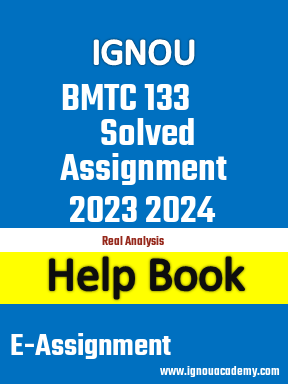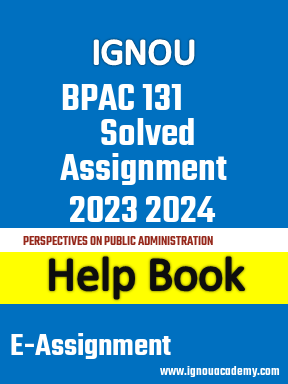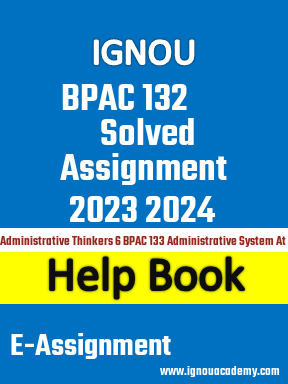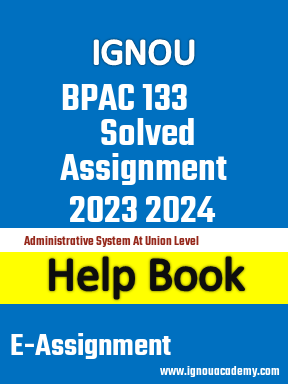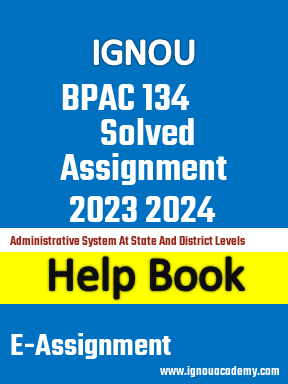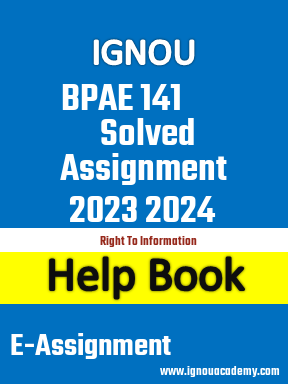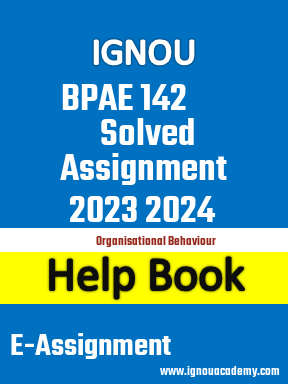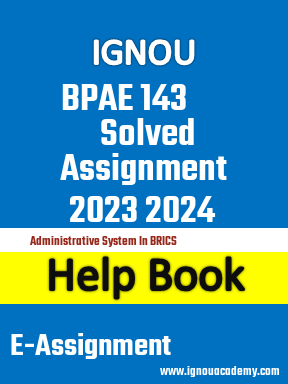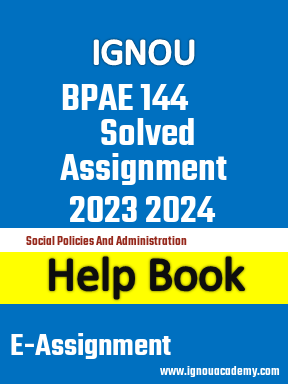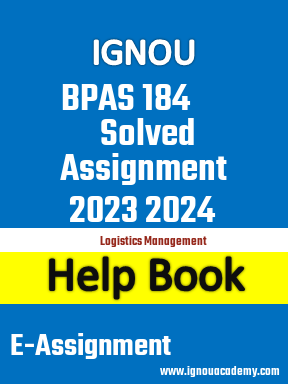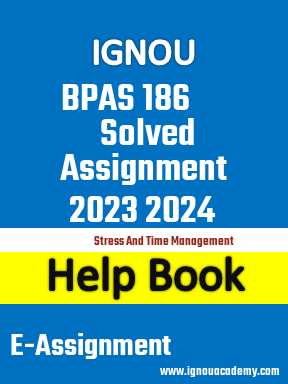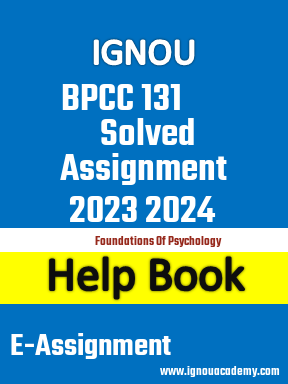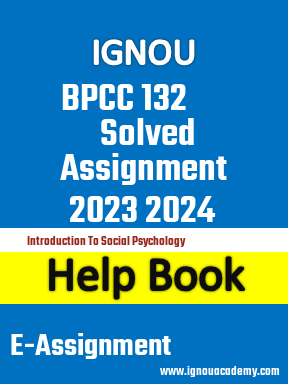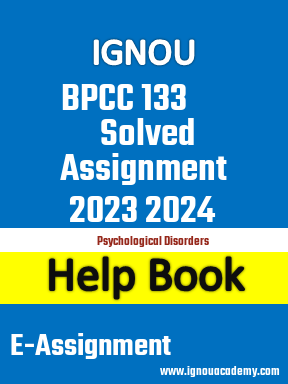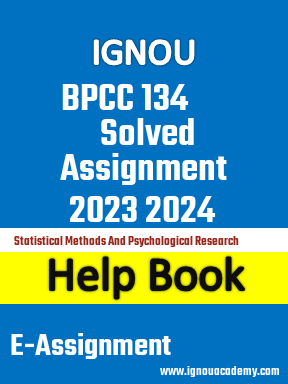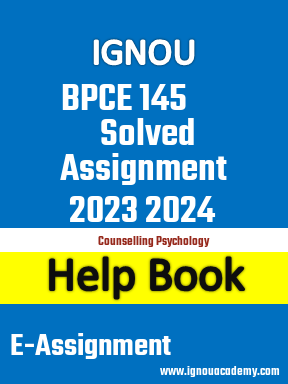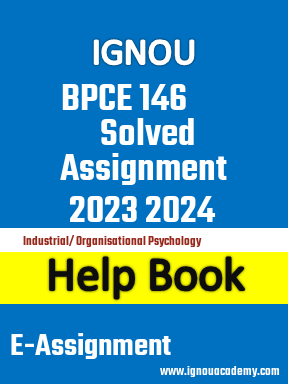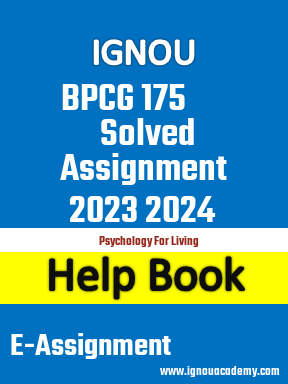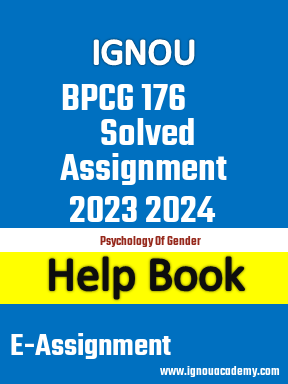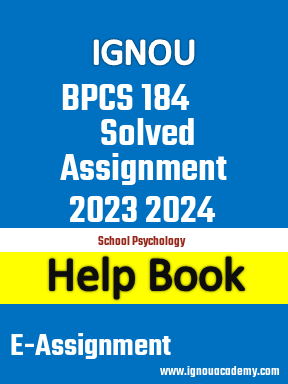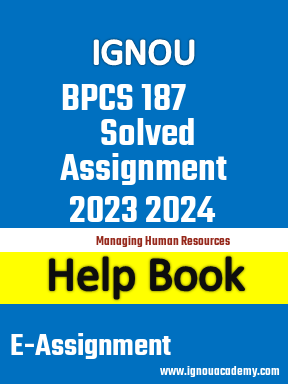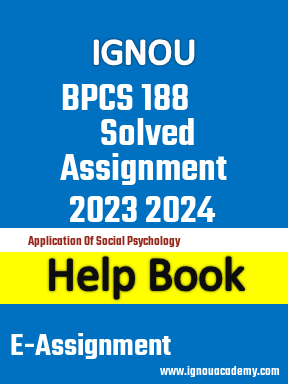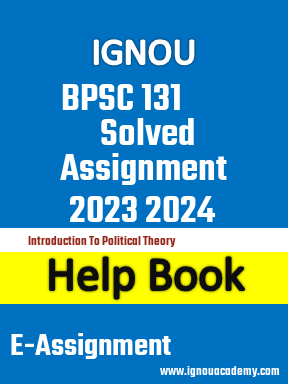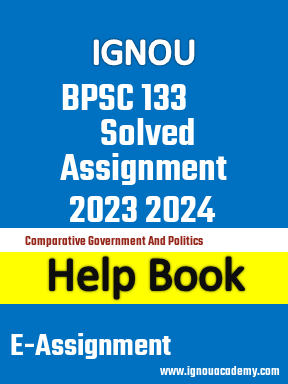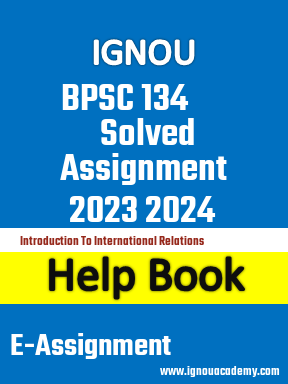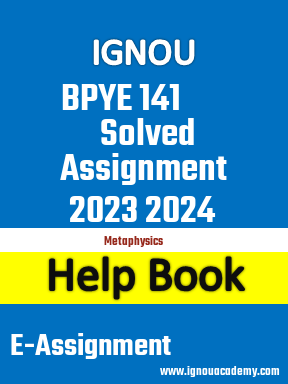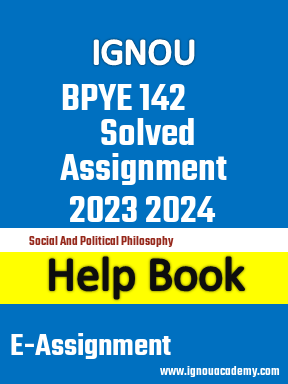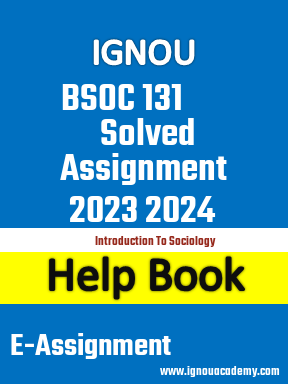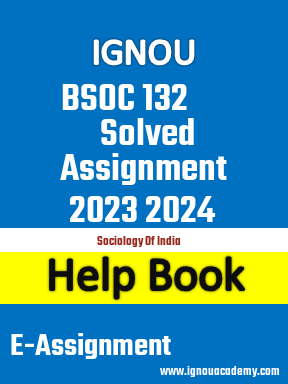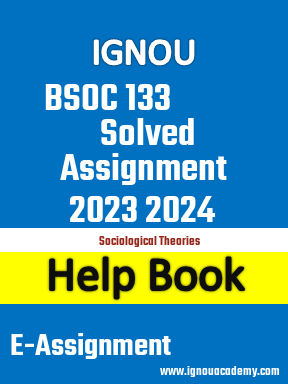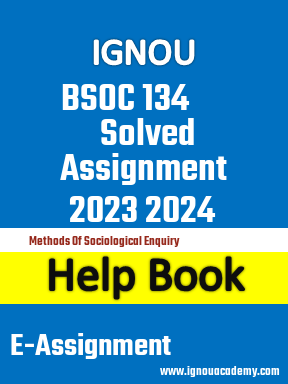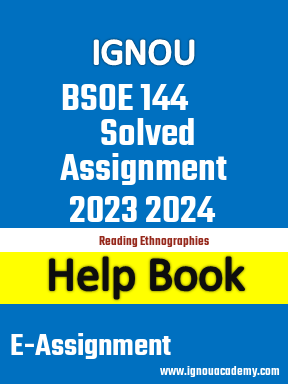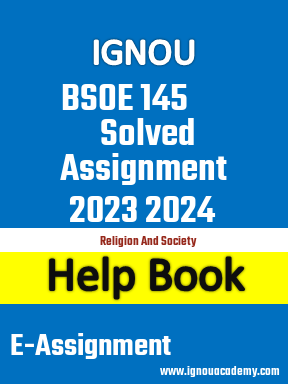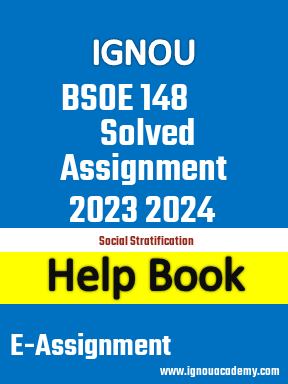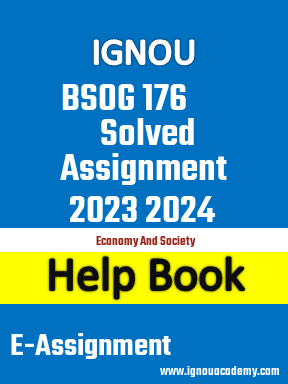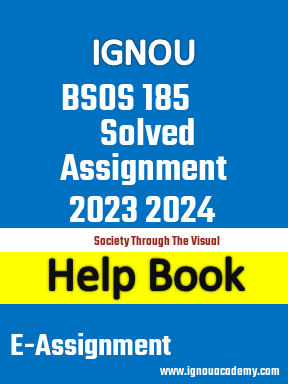My Cart

|
|
IGNOU BAG BEGE 145 2023 2024 Solution
IGNOU BAG BEGE 145 2023 2024 Solution|
|
| Title Name | IGNOU BAG BEGE 145 2023 2024 Solution |
|---|---|
| Type | Soft Copy (E-Assignment) .pdf |
| University | IGNOU |
| Degree | BACHELOR DEGREE PROGRAMMES |
| Course Code | BAG |
| Course Name | BACHELOR OF ARTS |
| Subject Code | BEGE 145 |
| Subject Name | Soft Skills |
| Year | 2023 2024 |
| Session | - |
| Language | English Medium |
| Assignment Code | BEGE-145/Assignmentt-1//2023-24 |
| Product Description | Assignment of BAG (BACHELOR OF ARTS) 2023-24. Latest BEGE 145 2023-24 Solved Assignment Solutions |
| Last Date of IGNOU Assignment Submission | Last Date of Submission of IGNOU BEGE-145 (BAG) 2023-24 Assignment is for January 2023 Session: 30th September, 2023 (for December 2023 Term End Exam). Semester Wise January 2023 Session: 30th March, 2024 (for June 2024 Term End Exam). July 2023 Session: 30th September, 2023 (for December 2023 Term End Exam). |
| Assignment Code | BEGE 145/2023 2024 |
|
|
Questions Included in this Help Book
Ques 1.
Read the following passage carefully and answer the questions given below it.
The modern workplace is a diverse and dynamic environment that thrives on the contributions of individuals
from various backgrounds. However, one aspect of diversity that has gained increasing attention is disability.
Disabilities encompass a wide range of conditions, both visible and invisible, that can impact an individual's
mobility, sensory perception, cognitive functions, and more. In recent years, there has been a growing
awareness of the need to create inclusive and accommodating workplaces that embrace employees with
disabilities.
Creating an inclusive workplace involves more than just meeting legal requirements; it requires a shift in
mindset and organizational culture. Employers are increasingly recognizing that individuals with disabilities
bring unique perspectives, talents, and strengths to the table. These individuals often demonstrate remarkable
resilience, adaptability, and problem-solving skills, qualities that can benefit teams and companies as a whole.
Reasonable accommodations play a pivotal role in enabling employees with disabilities to perform at their
best. These accommodations can range from physical modifications to the workspace, such as ramps or
accessible technology, to flexible work arrangements that are empathetic to an employee's needs. By
providing these accommodations, employers not only empower individuals with disabilities to contribute
effectively but also demonstrate a commitment to fostering an environment of equality and respect.
However, challenges remain. Stigma and misconceptions surrounding disabilities can persist, leading to biases
and exclusion. Awareness campaigns and training initiatives can help dismantle these barriers and promote a
more empathetic and informed work environment. Additionally, ensuring that hiring processes and career
advancement opportunities are inclusive can further encourage the integration of individuals with disabilities
into the workforce.
Ultimately, an inclusive workplace benefits everyone. It promotes a sense of belonging and community among
employees, leading to higher job satisfaction and retention rates. Moreover, when companies value diversity
in all its forms, they often experience improved creativity, innovation, and problem-solving, as different
perspectives and experiences converge to drive progress.
In conclusion, disability in the workplace is a multifaceted topic that demands attention and action. By
fostering an inclusive culture, providing reasonable accommodations, and challenging stereotypes, employers
can create environments where individuals with disabilities can thrive and contribute meaningfully. Embracing
disability in the workplace is not just a legal or moral obligation; it is an investment in a richer, more diverse,
and ultimately more successful working environment.
Q1 a) Answer the following questions
i. What is the significance of creating an inclusive workplace environment?
ii. How can reasonable accommodations positively impact employees with disabilities?
iii. What role do awareness campaigns and training initiatives play in addressing challenges
related to disabilities in the workplace?
iv. How does an inclusive workplace benefit both employees and companies?
v. What are some potential challenges individuals with disabilities might face in the workplace?
Ques 2.
Pick out words from the passage which mean the same as the following:
i. A variety of different people, ideas, and characteristics (para 1)
ii. The ability to understand and share the feelings and perspectives of others (para 3)
iii. To give someone the tools, authority, or confidence to take control of their situation and make
decisions (para 3)
iv. Preferences for or against individuals or groups, often without conscious awareness (para 4)
v. Negative perceptions or stereotypes that lead to discrimination or exclusion (para 4)
Ques 3.
What have you learnt in the passage above about creating a disability-inclusive workplace?
Ques 4.
What are blind spots in personality? Give examples.
Ques 5.
What are some steps to improve people management skills?
Ques 6.
How do biases affect teamwork?
Ques 7.
What are some factors that influence a personality?
Ques 8.
Here are the answers to some questions. What are the questions?
i. Where ____________________?
I went to a school in Delhi.
ii. Which college or university ____________________?
I attended IGNOU for my higher studies.
iii. What ____________________?
My field of study was English language.
iv. Have you ____________________?
Yes, I completed an online course on English grammar.
v. Have you ____________________?
Yes, I have considered pursuing higher studies in English language.
Ques 9.
Complete the following passage with either the present perfect or past simple tense of the verbs in
brackets (10)
In the diverse and culturally rich land of India, English occupies a unique position as a foreign language.
It (1) _____ (serve) as a bridge connecting the nation's linguistic diversity and providing access to global
opportunities. India's historical connection with English (2) _____ (date) back to the colonial era when it
(3) _____ (introduce) by the British. Over time, English (4) _____ (evolve) into an integral part of the
country's education system, professional landscape, and communication networks.
India's linguistic landscape is astonishingly varied, encompassing hundreds of languages and dialects.
This linguistic diversity can sometimes act as a barrier to effective communication between different
regions. English, with its status as a second language, (5) _____ (provide) a common ground for Indians
from various linguistic backgrounds to interact, share ideas, and collaborate seamlessly. It (6) _____
(act) as a lingua franca, enabling individuals to overcome linguistic barriers and (7) _____ (engage) in
both national and international discourse.
The Indian education system (8) _____ (embrace) English as a vital tool for academic and professional
advancement. Many private schools and prestigious institutions (9) _____ (conduct) their classes in
English, considering it a language of upward mobility. Proficiency in English (10) _____ (open) doors to
higher education opportunities abroad and enhances employability in various sectors such as IT,
business, medicine, and academia.
Q3 c) Complete these sentences with the corre
Ques 10.
Complete these sentences with the correct comparative or superlative form of the adjectives in brackets.
i. The internet is the _____ (fast) mode of communication.
ii. Social media is the _____ (late) fashion amongst teenagers.
iii. The large number of people make social media the _____ (rich) source of creativity.
iv. With billions of users, it is _____ (extensive) network in existence.
v. Constant innovations make the internet ____ (dynamic).
Ques 11.
Write a report of an event in your institution. Describe the following details:
i. The event timeline
ii. Major activities organised
iii. Response of the public
iv. Your contribution to the event
Ques 12.
Write a dialogue between two friends talking about adjusting to an academic life post-pandemic.
Ques 13.
Read the following passage carefully and answer the questions given below it.
The modern workplace is a diverse and dynamic environment that thrives on the contributions of individuals
from various backgrounds. However, one aspect of diversity that has gained increasing attention is disability.
Disabilities encompass a wide range of conditions, both visible and invisible, that can impact an individual's
mobility, sensory perception, cognitive functions, and more. In recent years, there has been a growing
awareness of the need to create inclusive and accommodating workplaces that embrace employees with
disabilities.
Creating an inclusive workplace involves more than just meeting legal requirements; it requires a shift in
mindset and organizational culture. Employers are increasingly recognizing that individuals with disabilities
bring unique perspectives, talents, and strengths to the table. These individuals often demonstrate remarkable
resilience, adaptability, and problem-solving skills, qualities that can benefit teams and companies as a whole.
Reasonable accommodations play a pivotal role in enabling employees with disabilities to perform at their
best. These accommodations can range from physical modifications to the workspace, such as ramps or
accessible technology, to flexible work arrangements that are empathetic to an employee's needs. By
providing these accommodations, employers not only empower individuals with disabilities to contribute
effectively but also demonstrate a commitment to fostering an environment of equality and respect.
However, challenges remain. Stigma and misconceptions surrounding disabilities can persist, leading to biases
and exclusion. Awareness campaigns and training initiatives can help dismantle these barriers and promote a
more empathetic and informed work environment. Additionally, ensuring that hiring processes and career
advancement opportunities are inclusive can further encourage the integration of individuals with disabilities
into the workforce.
Ultimately, an inclusive workplace benefits everyone. It promotes a sense of belonging and community among
employees, leading to higher job satisfaction and retention rates. Moreover, when companies value diversity
in all its forms, they often experience improved creativity, innovation, and problem-solving, as different
perspectives and experiences converge to drive progress.
In conclusion, disability in the workplace is a multifaceted topic that demands attention and action. By
fostering an inclusive culture, providing reasonable accommodations, and challenging stereotypes, employers
can create environments where individuals with disabilities can thrive and contribute meaningfully. Embracing
disability in the workplace is not just a legal or moral obligation; it is an investment in a richer, more diverse,
and ultimately more successful working environment.
a) Answer the following questions (5 x 2 = 10)
i. What is the significance of creating an inclusive workplace environment?
Ques 14.
Read the following passage carefully and answer the questions given below it.
The modern workplace is a diverse and dynamic environment that thrives on the contributions of individuals
from various backgrounds. However, one aspect of diversity that has gained increasing attention is disability.
Disabilities encompass a wide range of conditions, both visible and invisible, that can impact an individual's
mobility, sensory perception, cognitive functions, and more. In recent years, there has been a growing
awareness of the need to create inclusive and accommodating workplaces that embrace employees with
disabilities.
Creating an inclusive workplace involves more than just meeting legal requirements; it requires a shift in
mindset and organizational culture. Employers are increasingly recognizing that individuals with disabilities
bring unique perspectives, talents, and strengths to the table. These individuals often demonstrate remarkable
resilience, adaptability, and problem-solving skills, qualities that can benefit teams and companies as a whole.
Reasonable accommodations play a pivotal role in enabling employees with disabilities to perform at their
best. These accommodations can range from physical modifications to the workspace, such as ramps or
accessible technology, to flexible work arrangements that are empathetic to an employee's needs. By
providing these accommodations, employers not only empower individuals with disabilities to contribute
effectively but also demonstrate a commitment to fostering an environment of equality and respect.
However, challenges remain. Stigma and misconceptions surrounding disabilities can persist, leading to biases
and exclusion. Awareness campaigns and training initiatives can help dismantle these barriers and promote a
more empathetic and informed work environment. Additionally, ensuring that hiring processes and career
advancement opportunities are inclusive can further encourage the integration of individuals with disabilities
into the workforce.
Ultimately, an inclusive workplace benefits everyone. It promotes a sense of belonging and community among
employees, leading to higher job satisfaction and retention rates. Moreover, when companies value diversity
in all its forms, they often experience improved creativity, innovation, and problem-solving, as different
perspectives and experiences converge to drive progress.
In conclusion, disability in the workplace is a multifaceted topic that demands attention and action. By
fostering an inclusive culture, providing reasonable accommodations, and challenging stereotypes, employers
can create environments where individuals with disabilities can thrive and contribute meaningfully. Embracing
disability in the workplace is not just a legal or moral obligation; it is an investment in a richer, more diverse,
and ultimately more successful working environment.
How can reasonable accommodations positively impact employees with disabilities?
Ques 15.
Awareness campaigns and training initiatives play a crucial role in addressing challenges related to disabilities in the workplace. They contribute to creating a more inclusive and supportive work environment in the following ways:
- Promoting Understanding: Awareness campaigns and training initiatives educate employees and employers about disabilities, their different forms, and the challenges individuals with disabilities may face. This increased understanding reduces stereotypes, misconceptions, and biases, fostering empathy and respect.
- Reducing Stigma: These initiatives help reduce the stigma associated with disabilities by encouraging open dialogue and discussions. Employees are more likely to feel comfortable disclosing their disabilities and seeking the necessary accommodations when stigma is minimized.
- Compliance with Legal Requirements: Many countries have laws and regulations that require organizations to provide reasonable accommodations and ensure equal opportunities for employees with disabilities. Awareness campaigns and training ensure that employers and employees are aware of and comply with these legal requirements.
- Promoting Inclusivity: Awareness campaigns and training promote a culture of inclusivity. They emphasize the value of diverse perspectives and contributions, reinforcing the idea that all employees, regardless of their abilities, have a place and role within the organization.
- Facilitating Disclosure: Employees may be hesitant to disclose their disabilities due to fear of discrimination or misunderstanding. Training initiatives can provide guidance on how to disclose disabilities and request accommodations, making the process smoother and less intimidating.
- Providing Practical Knowledge: Training initiatives often provide practical guidance on creating accessible workplaces, making adjustments, and implementing accommodations. This empowers employers and HR professionals with the knowledge and tools needed to support employees with disabilities effectively.
- Creating Allies: Awareness campaigns and training can turn employees into allies. When colleagues understand the challenges faced by their peers with disabilities, they are more likely to offer support, assistance, and camaraderie.
- Improving Communication: Training can enhance communication between employees with disabilities and their supervisors or colleagues. It can teach effective ways to discuss accommodations, needs, and preferences, leading to better collaboration.
- Enhancing Leadership Skills: Training programs for managers and supervisors can equip them with leadership skills to effectively manage and support employees with disabilities. This includes providing accommodations, handling performance evaluations, and addressing any workplace conflicts.
- Conflict Resolution: Training initiatives often include conflict resolution strategies specific to disability-related issues. This can help prevent and resolve conflicts that may arise due to misunderstandings or differences in accommodation needs.
- Creating a Supportive Network: Awareness campaigns can facilitate the formation of employee resource groups or networks focused on disabilities. These groups can provide emotional support, share experiences, and offer guidance to employees with disabilities.
- Increasing Confidence: Employees with disabilities may gain confidence in advocating for themselves and their needs in the workplace after participating in training. This confidence can empower them to pursue career advancement opportunities.
- Monitoring Progress: Awareness campaigns and training can include mechanisms for monitoring and assessing the organization's progress in promoting disability inclusion. This allows for continuous improvement and adjustment of policies and practices.
In summary, awareness campaigns and training initiatives are essential tools for addressing challenges related to disabilities in the workplace. They promote understanding, reduce stigma, facilitate compliance with legal requirements, and empower both employees and employers to create a more inclusive and supportive work environment for individuals with disabilities.
What role do awareness campaigns and training initiatives play in addressing challenges
related to disabilities in the workplace?
Ques 16.
Read the following passage carefully and answer the questions given below it.
The modern workplace is a diverse and dynamic environment that thrives on the contributions of individuals
from various backgrounds. However, one aspect of diversity that has gained increasing attention is disability.
Disabilities encompass a wide range of conditions, both visible and invisible, that can impact an individual's
mobility, sensory perception, cognitive functions, and more. In recent years, there has been a growing
awareness of the need to create inclusive and accommodating workplaces that embrace employees with
disabilities.
Creating an inclusive workplace involves more than just meeting legal requirements; it requires a shift in
mindset and organizational culture. Employers are increasingly recognizing that individuals with disabilities
bring unique perspectives, talents, and strengths to the table. These individuals often demonstrate remarkable
resilience, adaptability, and problem-solving skills, qualities that can benefit teams and companies as a whole.
Reasonable accommodations play a pivotal role in enabling employees with disabilities to perform at their
best. These accommodations can range from physical modifications to the workspace, such as ramps or
accessible technology, to flexible work arrangements that are empathetic to an employee's needs. By
providing these accommodations, employers not only empower individuals with disabilities to contribute
effectively but also demonstrate a commitment to fostering an environment of equality and respect.
However, challenges remain. Stigma and misconceptions surrounding disabilities can persist, leading to biases
and exclusion. Awareness campaigns and training initiatives can help dismantle these barriers and promote a
more empathetic and informed work environment. Additionally, ensuring that hiring processes and career
advancement opportunities are inclusive can further encourage the integration of individuals with disabilities
into the workforce.
Ultimately, an inclusive workplace benefits everyone. It promotes a sense of belonging and community among
employees, leading to higher job satisfaction and retention rates. Moreover, when companies value diversity
in all its forms, they often experience improved creativity, innovation, and problem-solving, as different
perspectives and experiences converge to drive progress.
In conclusion, disability in the workplace is a multifaceted topic that demands attention and action. By
fostering an inclusive culture, providing reasonable accommodations, and challenging stereotypes, employers
can create environments where individuals with disabilities can thrive and contribute meaningfully. Embracing
disability in the workplace is not just a legal or moral obligation; it is an investment in a richer, more diverse,
and ultimately more successful working environment.
How does an inclusive workplace benefit both employees and companies?
Ques 17.
Read the following passage carefully and answer the questions given below it.
The modern workplace is a diverse and dynamic environment that thrives on the contributions of individuals
from various backgrounds. However, one aspect of diversity that has gained increasing attention is disability.
Disabilities encompass a wide range of conditions, both visible and invisible, that can impact an individual's
mobility, sensory perception, cognitive functions, and more. In recent years, there has been a growing
awareness of the need to create inclusive and accommodating workplaces that embrace employees with
disabilities.
Creating an inclusive workplace involves more than just meeting legal requirements; it requires a shift in
mindset and organizational culture. Employers are increasingly recognizing that individuals with disabilities
bring unique perspectives, talents, and strengths to the table. These individuals often demonstrate remarkable
resilience, adaptability, and problem-solving skills, qualities that can benefit teams and companies as a whole.
Reasonable accommodations play a pivotal role in enabling employees with disabilities to perform at their
best. These accommodations can range from physical modifications to the workspace, such as ramps or
accessible technology, to flexible work arrangements that are empathetic to an employee's needs. By
providing these accommodations, employers not only empower individuals with disabilities to contribute
effectively but also demonstrate a commitment to fostering an environment of equality and respect.
However, challenges remain. Stigma and misconceptions surrounding disabilities can persist, leading to biases
and exclusion. Awareness campaigns and training initiatives can help dismantle these barriers and promote a
more empathetic and informed work environment. Additionally, ensuring that hiring processes and career
advancement opportunities are inclusive can further encourage the integration of individuals with disabilities
into the workforce.
Ultimately, an inclusive workplace benefits everyone. It promotes a sense of belonging and community among
employees, leading to higher job satisfaction and retention rates. Moreover, when companies value diversity
in all its forms, they often experience improved creativity, innovation, and problem-solving, as different
perspectives and experiences converge to drive progress.
In conclusion, disability in the workplace is a multifaceted topic that demands attention and action. By
fostering an inclusive culture, providing reasonable accommodations, and challenging stereotypes, employers
can create environments where individuals with disabilities can thrive and contribute meaningfully. Embracing
disability in the workplace is not just a legal or moral obligation; it is an investment in a richer, more diverse,
and ultimately more successful working environment.
What are some potential challenges individuals with disabilities might face in the workplace?
Ques 18.
Pick out words from the passage which mean the same as the following: (5 x 1 = 5)
i. A variety of different people, ideas, and characteristics (para 1)
Ques 19.
The ability to understand and share the feelings and perspectives of others (para 3)
Ques 20.
To give someone the tools, authority, or confidence to take control of their situation and make
decisions (para 3)
Ques 21.
Preferences for or against individuals or groups, often without conscious awareness (para 4)
Ques 22.
Negative perceptions or stereotypes that lead to discrimination or exclusion (para 4)
Ques 23.
What have you learnt in the passage above about creating a disability-inclusive workplace?
Ques 24.
Write short notes on any two of the following: (2 x 10 =20)
i. What are blind spots in personality? Give examples.
Ques 25.
What are some steps to improve people management skills?
Ques 26.
How do biases affect teamwork?
Ques 27.
What are some factors that influence a personality?
Ques 28.
Here are the answers to some questions. What are the questions? (5 x 1 =5)
i. Where ____________________?
I went to a school in Delhi.
ii. Which college or university ____________________?
I attended IGNOU for my higher studies.
iii. What ____________________?
My field of study was English language.
iv. Have you ____________________?
Yes, I completed an online course on English grammar.
v. Have you ____________________?
Yes, I have considered pursuing higher studies in English language.
Ques 29.
Complete the following passage with either the present perfect or past simple tense of the verbs in
brackets (10)
In the diverse and culturally rich land of India, English occupies a unique position as a foreign language.
It (1) _____ (serve) as a bridge connecting the nation's linguistic diversity and providing access to global
opportunities. India's historical connection with English (2) _____ (date) back to the colonial era when it
(3) _____ (introduce) by the British. Over time, English (4) _____ (evolve) into an integral part of the
country's education system, professional landscape, and communication networks.
India's linguistic landscape is astonishingly varied, encompassing hundreds of languages and dialects.
This linguistic diversity can sometimes act as a barrier to effective communication between different
regions. English, with its status as a second language, (5) _____ (provide) a common ground for Indians
from various linguistic backgrounds to interact, share ideas, and collaborate seamlessly. It (6) _____
(act) as a lingua franca, enabling individuals to overcome linguistic barriers and (7) _____ (engage) in
both national and international discourse.
The Indian education system (8) _____ (embrace) English as a vital tool for academic and professional
advancement. Many private schools and prestigious institutions (9) _____ (conduct) their classes in
English, considering it a language of upward mobility. Proficiency in English (10) _____ (open) doors to
higher education opportunities abroad and enhances employability in various sectors such as IT,
business, medicine, and academia.
Q3 c) Complete these sentences with the correct comparative or superlative form of the adjectives in brackets
(5 x 1=5)
i. The internet is the _____ (fast) mode of communication.
ii. Social media is the _____ (late) fashion amongst teenagers.
iii. The large number of people make social media the _____ (rich) source of creativity.
iv. With billions of users, it is _____ (extensive) network in existence.
v. Constant innovations make the internet ____ (dynamic).
Ques 30.
Write a report of an event in your institution. Describe the following details: (20)
i. The event timeline
Ques 31.
Write a report of an event in your institution. Describe the following details.
Major activities organised
Ques 32.
Write a report of an event in your institution. Describe the following details.
Response of the public
Ques 33.
Write a report of an event in your institution. Describe the following details.
Your contribution to the event
Ques 34.
Write a dialogue between two friends talking about adjusting to an academic life post-pandemic.
|
|
Related Assignments
IGNOU Doubts & Queries
Click to Contact Us
Call - 9199852182 Call - 9852900088 myabhasolutions@gmail.com WhatsApp - 9852900088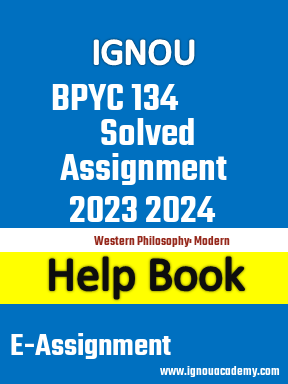
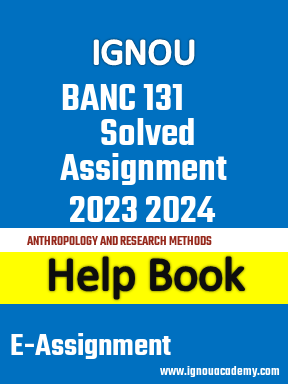
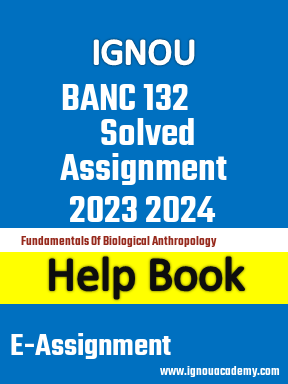
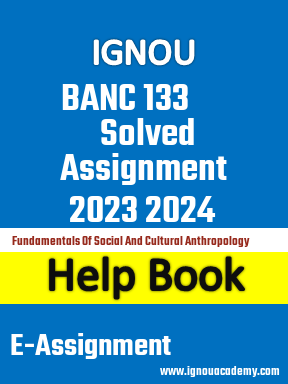

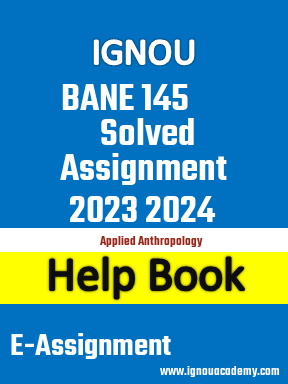
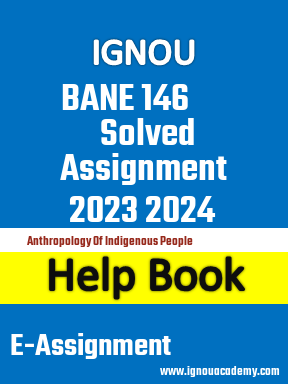







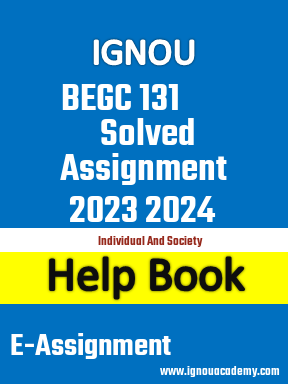









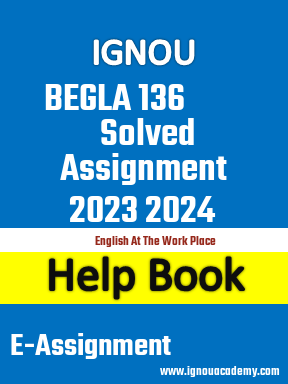




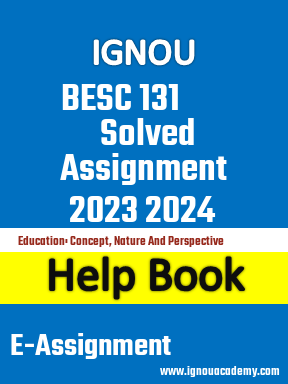

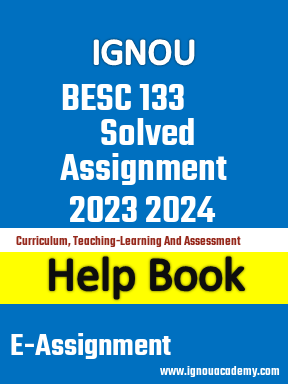
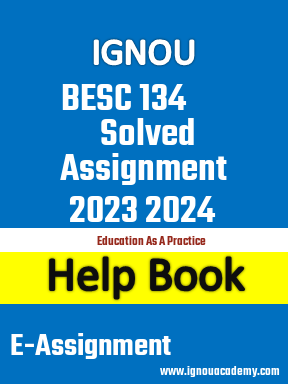
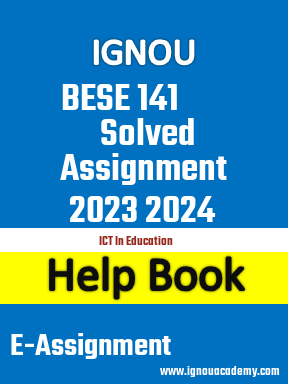
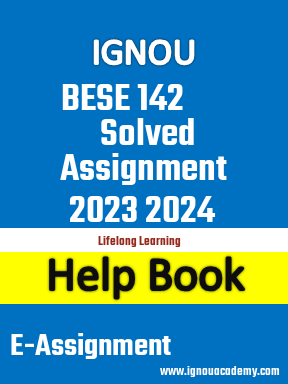





&y=&topic=&dl=&k=.png)



